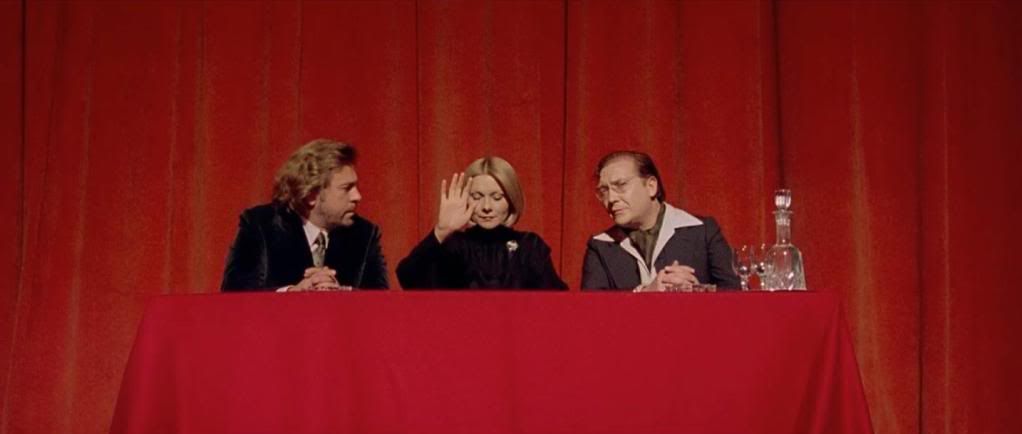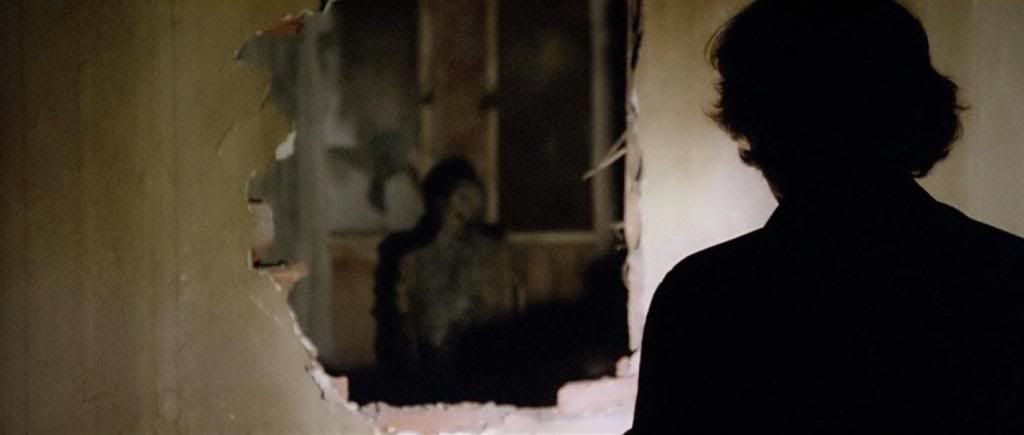

Dario Argento's Deep Red is the predecessor of the director's unsettling Suspiria, sharing with that film a bright, colorful aesthetic, here with a particular emphasis on the red of the title. At times meandering and oddly paced — after a riveting opening, the film wanders aimlessly for quite a bit of its length — Deep Red is nevertheless dotted with enough striking, brilliantly composed images and chilling set pieces to make it compelling and often creepy.
Certainly, the film starts incredibly strong, doling out a few mysterious images — like a child's stockinged feet approaching a bloody knife on Christmas morning — during the credits, establishing the primal scene of violence that will drive the rest of the film. The film's best sequence is the extended opening featuring the psychic Helga (Macha Meril), who, during a demonstration of her powers, is suddenly assaulted by violent thoughts from someone in the audience. Argento stages this stunning sequence on a dramatic stage decorated with red-on-red: the dais at which the psychic sits is draped in a red cloth, and the curtains behind her are also red, so that she's surrounded by bright, bloody red as she writhes and cries out, overcome by the darkness and malevolence she unexpectedly finds drifting into her mind from somebody in the audience.
Argento's camera, taking on the point-of-view of this mysterious evil presence, shakes and jitters as the killer retreats from the theater. Throughout the film, Argento several times indicates the killer's perspective with this kind of handheld camera, most unsettlingly in the subsequent scene where Helga leaves the now-empty theater, still sensing the presence of those horrible thoughts, as the camera peeks out at her from behind a nearby pillar. The camera seems to be shaking with the killer's excited heavy breathing, with the thrill of the chase, establishing a voyeuristic perspective that aligns the camera, and the watching audience, with the hidden killer's vantage point. Soon, Helga is a victim, her gruesome murder witnessed by her neighbor Marc (David Hemmings), who begins investigating the killer while the body count, predictably, keeps getting higher and higher.


Argento's visual inventiveness is at its peak during the film's gory murder sequences, each of them a taut and unsettling set piece that's perfectly designed. In one scene, the killer's presence in a dark closet is indicated by a single eye suddenly opening in the darkness, at which point Argento's camera zooms in to capture that one eye staring out of the surrounding blackness. In another scene, for some reason the killer's appearance is preceded by an utterly creepy doll that jauntily jogs towards the terrified victim, cackling and waving its motorized arms in front of it. The doll's appearance is made even more unsettling by the casual way that Argento frames it, initially in a long shot in which the doll's unnatural movement is very disturbing, before cutting in for the obligatory closeup of its grinning plastic face.
These eerie scenes are spaced out through the film, providing periodic bursts of insane imagery and bright red blood that looks like paint. Much of the film is dedicated to Marc's slow, hesitant investigation, assisted by the reporter Gianna (Daria Nicolodi), and there's something of a disconnect between the baroque scenes of violence and the surrounding ordinariness of the rest of the movie. The film sometimes feels a little slack whenever the killer's not around, though the oddball humor and quirky fringe characters help to liven things up whenever the tension dissipates. There's a subtext of sexual insecurity in Marc, who's beaten at arm-wrestling by Gianna, and feels cramped and claustrophobic in her car, sitting significantly lower than her in the broken passenger seat, making him look very foolish next to her. Later, he visits his friend Carlo (Gabriele Lavia) and discovers that Carlo is gay, staying with a feminine man who might pass for a woman if not for his peach-fuzz mustache.
Much of the film's comic relief, especially the bizarre scenes featuring Carlo's mother (Clara Calamai), winds up tying into the film's twisty ending, but before this, the comic tone and alternation of suspense with the meandering investigative scenes gives the film a strange, disjointed feeling. The jangly, chiming prog rock soundtrack by Goblin (who'd go on to top themselves with their even better score for Suspiria) adds to the film's strangeness, the music resonating with the childlike melody that serves as the killer's trademark and connects these crimes to some sort of traumatic childhood incident. Deep Red is ultimately a very strange movie, its rambling pace spiked with scenes of violence that are made almost beautiful through the filter of Argento's aesthetic.

4 comments:
though I'd like both 'Suspiria' and 'Inferno' more than 'Deep Red', the film is such an important statement from Argento that deserved a review like this. Nice one.
You're so right, Ed. This is an important step for Argento and for Italian horror. It was one of the first films to mix the ethereal with the procedural aspects of the giallo. I love the scene you mention with the dummy. You're right, it's in the way that Argento frames it: it's so normal looking; that's what's so disorienting about it.
And this is the first film where Argento really gives himself over to the disorienting style of his lesser known contemporaries like Pupi Avati, Francesco Barilli, and Sergio Martino and their respective classics THE HOUSE WITH LAUGHING WINDOWS, THE PERFUME OF THE LADY IN BLACK, and ALL THE COLORS OF THE DARK -- three films that are massively important in the history of '70s Italian horror but are not as well known as Argento's. With DEEP RED, you can see where Argento is heading, and even though many consider this his masterpiece (and it's damn close to being my favorite of his movies), I much prefer his more ethereal style.
Be interested to see if you cover the "sequel" to SUSPIRIA, INFERNO? The opening to INFERNO is fantastic and was guest directed by Mario Bava.
Great thoughts here, as always, Ed!
This is my second favorite Argento after Suspiria, the scene with the clairvoyant in the theater is my favorite scene, followed by the one you mentioned about the doll, that scene with the doll was so freaking eeerie. Love this movie because of how much care was taken with the imagery and the colors, a true delight to watch. Looking forward to giving this one a rewatch! I've got to do an Argento month type of deal!
Excellent work here Ed. I also like SUSPIRIA, INFERNO and CRYSTAL PLUMAGE, but this is an ultra-important film in this genre, and the forerunner of many imitations to come. It is playing this month at Manhattan's Anthology Film Archives as part of their comprehensive 'Giallo' Festival.
Post a Comment